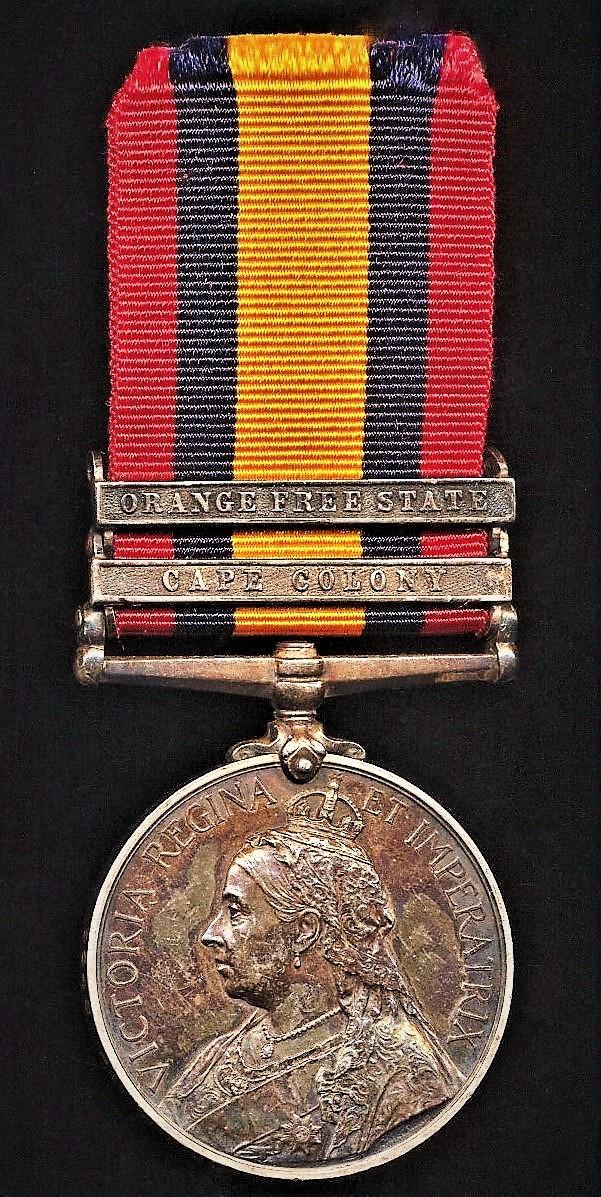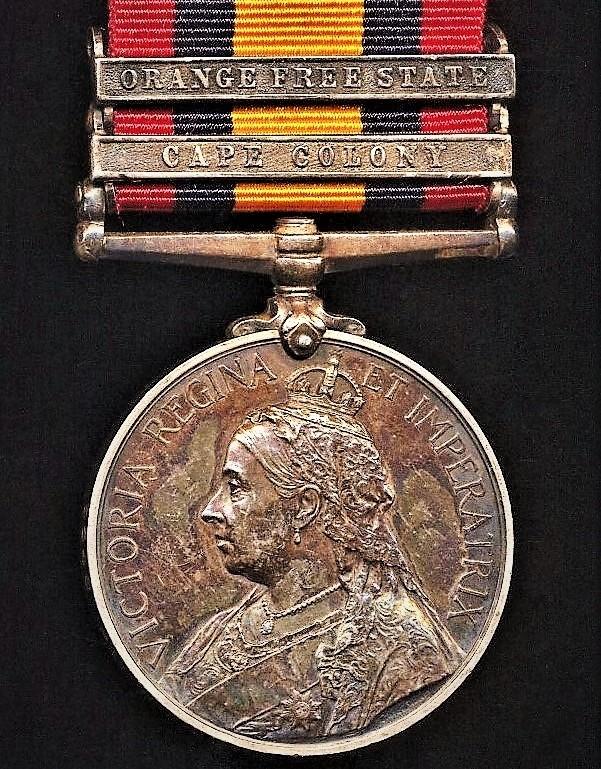Queen's South Africa Medal. Silver issue with 2 x clasps ' Cape Colony' & 'Orange Free State' (3548 Pte. H. Young, Bedford Regt)
Killed-in-Action: Private H. Young, 2nd Battalion Bedfordshire Regiment, is confirmed being Killed-inAction, when he was 'Shot through the Head' by Commandant P. Botha, at Thaba Nchu, 16 November 1900. Private Young was one of five Bedfordshire Regiment 'All-Rank's' killed or mortally wounded in the same engagement
The fate of all the Bedford's casualties, including Private Young, was detailed for posterity, in a newspaper article that was subsequently published in the Luton Times and Advertiser of 29 issue of, 28 December 1900:
Quote,
WAR NEWS
A Beds. Patrol Surprised.
HOW LT. PAXTON WAS KILLED
The "Bristol Times and Mirror", has published, from it's correspondent at the front, a graphic account of a disaster to a patrol of Bedfordshire Mounted Infantry. The writer, who dates his letter "Thabanchu. November 22nd," says:-
"The past week has been a time of great expectation for the Volunteers, as large forces of the enemy have been in vicinity of Thabanchu. On the morning of the 16th, Lt. Paxton was sent out with a patrol of the mounted infantry belonging to the Bedford Regiment. The patrol got about 4 miles away from camp, when they were attacked by a strong patrol of the enemy, numbering about 50 men, under the command of General P. Botha. When the patrol reached some rough ground near Eden Farm, the officer left two men, Privates Harvey and Duffin, on a small kopje. Soon afterwards the patrol was suddenly fired on. The patrol now consisted of Lt. Paxton, Lance-Corporal G. Horner, Privates Young, Gardiner, Trowel, and Gosden. Gardiner was the first to fall, shot near the heart. Gosden, who was next to him, crawled along to see if he could render assistance, but found that the poor fellow was just expiring, and was in time to catch his last words which were "Oh, my poor mother." Gosden who was slightly wounded in the right forearm, was captured, after the Boers had formed a complete circle around him, and was relived of his arms and ammunition. These shots were fired from a nullah about 100 yards away, and the enemy at once tried to surround the whole party, and soon closed up to within twenty to thirty yards; but from the first it was evident that the patrol had no chance against such odds.
LIEUT. PAXTON WAS THEN SHOT
through the head, and death must have been instantaneous. When the officer was killed, Corporal Horner gave the order to mount and retire to a kopje behind, which was better suited for defence. The patrol, however, was unable to reach this, for as soon as they started the corporal's horse was shot through the back, and a bullet also struck his haversack, but the missile, very luckily for the N.C.O., struck a metal spoon and glanced off. The bullets all this time were whistling round the heads of the men, and the corporal's horse threw his rider heavily to the ground, when he was, like Gosden, captured and disarmed. The corporal then had to remain a passive spectator of his comrade's death. Trowell's horse next fell, shot in two places, and he himself shot in the abdomen. Young was first shot in the jaw, and then got up and shot at Commandant Botha, but just missed the Boer leader, who, with his revolver, instantly shot the private through the head. After these men were disposed of, the Dutchemen galloped up over the hill to catch Harvey and Duffin, who had been left behind. But Harvey, having been to the top of the hill after hearing the shots, and witnessed the fates of his companion's, ran down to Duffin, and together they started to ride for camp. But just as they were getting away, the Boers reached the top of the hill and shot Harvey through the back, the bullet going in at the right side and out at the left. Duffin then made off as fast as he could until he reached a spruit, which he could not get his horse to go into, so he quickly got off his steed and abandoned it, and ran along the spruit, the Boers firing all the time and at length got clean off, having 4 miles to go to get into camp. Some of the Boers were dressed in khaki, with putties and slouch hats, and some even had stripes on their arms. Harvey was taken into Thabanchu Hospital, and is progressing favourably. The officer and men were buried the next day in Thabanchu cemetery."
Unquote.
Medal and clasps verification The QSA medal with both clasps is verified as entitled per the respective campaign medal roll of the Bedford Regiment, cited below:
- QSA with 2 x clasps: WO 100/176, compiled at Sanna's Post, 26 July 1901
The recipient had enlisted in the British Army in March 1890 (No. 3547 Edward Goddard, s recorded as enlisting in the Bedfordshire Regiment on, 11 March 1890, and like Private Young was posted to 1/Bedfords) , at which time he was posted to the Bedfordshire Regiment, subsequently serving with 1st Battalion Bedfordshire Regiment. Private Young, had prior to the South African War, served on the North West Frontier of India, for which he had earlier qualified for an Indian General Service Medal with clasp 'Relief of Chitral 1895' (ref WO 100/78)
Boer Commando Commandant: The General/ Commandant referred to in above account, is believed to be General Philip Botha, who was CommandaNt of the Kroonstad Commando
A rare documented South African War battle casualty to the Bedford Regiment
Condition: Toned about EF
Code: 22780







